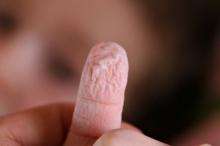March 10, 2011 report
Study explains why soggy skin gets wrinkly but does not dissolve

(PhysOrg.com) -- A new study by mathematicians in Australia has explained how skin remains stable in water and does not dissolve, and why it wrinkles and remains a strong barrier even after absorbing large quantities of water.
Myfanwy Evans, a mathematician at the Research School of Physics and Engineering at the Australian National University in Canberra, and her colleagues developed a stringy skin model to try to explain how the network of keratin fibers in the skin is arranged. Keratin is a fibrous protein also found in the nails and hair. Scientists already knew the keratin networks were important, but until now no one was certain of their structure.
After a period in water the outer layer of the skin (the stratum corneum) expands, producing prune-like wrinkles. Earlier researchers suggested the stratum corneum expands as it absorbs water, but no one had yet explained why skin doesn’t fall apart when it has expanded.
Keratin is known to prevent evaporation from the skin and to absorb water to help keep the skin hydrated. The stratum corneum layer also gives the skin its stretchy properties and the ability to spring back.
Using computer modeling Evans approached the question from a geometric point of view to try to explain why skin maintains its structural rigidity after long exposure to water. She said the outer layer of skin contains a three-dimensional pattern of keratin fibers woven together to form a structure capable of acting like a sponge.
The fibers are helical when dry but straighten out as water is absorbed, which allows the network to hold a greater volume of water. All the contacts between the keratin fibers remain intact throughout the expansion, and this makes the material structurally stable, Evans said.
Evans, who has just completed her PhD, said after 24 hours submerged in water, the skin can suffer irreversible damage.
Evans specializes in the study of gyroids, which are mathematical shapes first described by a NASA scientist, Alan Schoen in 1970. Since then, gyroids have been found in nature, such as in some butterflies, where light refracted through crystalline gyroids in the wings produce the vivid colors.
Evans said an understanding of the geometry behind why skin wrinkles after too long in the bath could help scientists design materials with the properties of skin, able to stretch without losing strength. The paper will be published in the cross-disciplinary publication, the Journal of the Royal Society Interface.
© 2010 PhysOrg.com

















